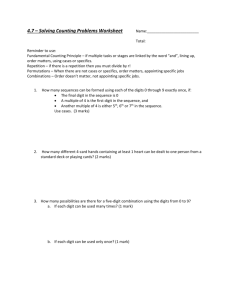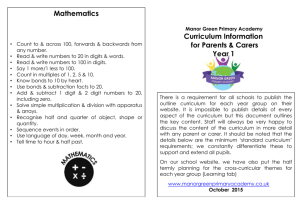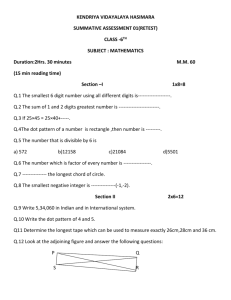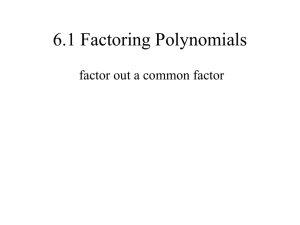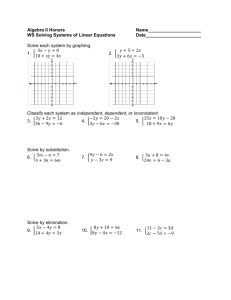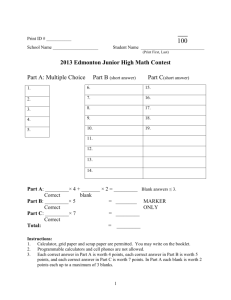150 KB
advertisement
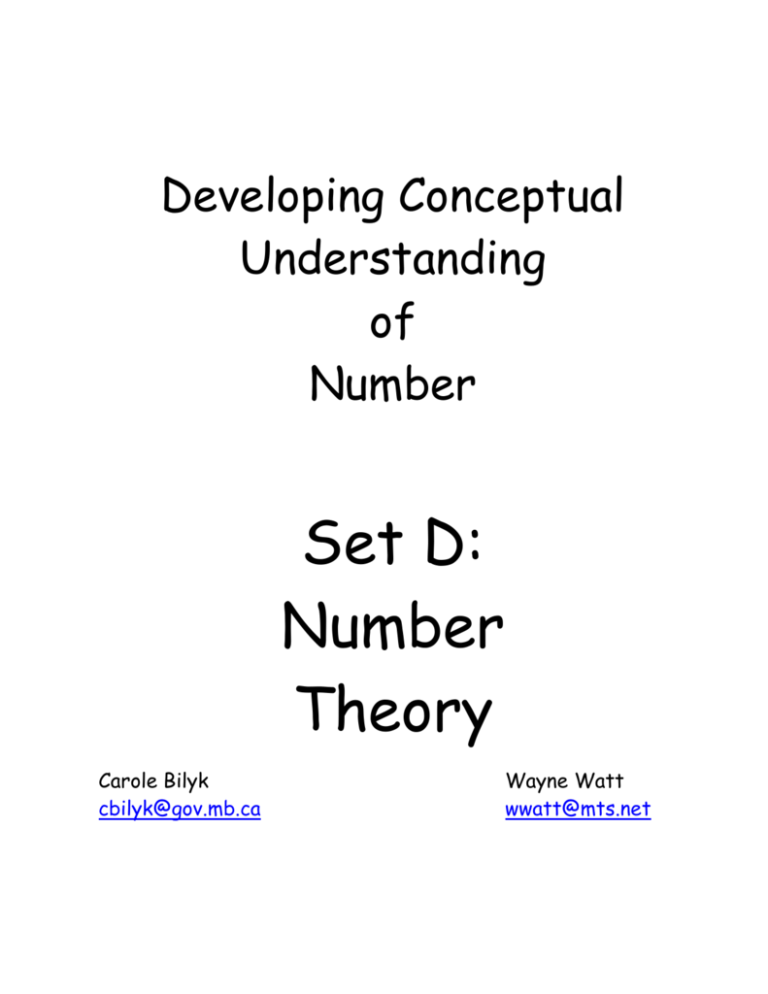
Developing Conceptual Understanding of Number Set D: Number Theory Carole Bilyk cbilyk@gov.mb.ca Wayne Watt wwatt@mts.net Number Theory 1 Vocabulary digit hundred’s place whole numbers even factor denominator numerator odd multiple prime composite Notes Answers 1. a) b) c) 4 second digit before the decimal (6) 7 2. a) b) c) d) e) 9, 10, 11 658, 659 40, 41 4, 6 5, 7 3. a) b) c) d) 490 11 32 21 4. a) b) c) 7 5 15 For 4a), students need to understand 1 that is the same as 2 8 . 16 8D-1 Number Theory 1 1. For the number 2467.5 , what digit: a) is in the hundred’s place? b) has a value of 60? c) is in the one’s position? 2. Identify all the whole numbers that are: a) between 8 and 12 b) between 657 and 660 c) between 39.2 and 41.9 d) even and between 2 and 7 e) odd and satisfy 4 < n < 9 3. Find a whole number that is: a) a multiple of 2 between 488 and 492 b) prime and between 8 and 12 c) the first composite number after 30 d) odd, satisfies 16 < r < 23, and has a factor of 3 4. Consider fractions with a denominator of 16. Choose a whole number numerator that would make the fraction: a) a little less than one-half. b) a little more than one-quarter c) almost 1 ? 16 8D-1 Number Theory 2 Vocabulary thousand’s place place value location divisible Notes Answers 1. a) b) c) d) 6 5 tens 1 hundred or 100 2. a) Possible Answers: from largest to smallest decreasing order descending order … Possible Answers: in ten’s position third from the left between 6 and 1 … 165 96 Question #3 builds on the questions from Representing Numbers. b) c) d) 3. a) Possible Answers: There are 3 because 139 added to 721 does not get over 1000 which is where it switches to 4 digits. … b) Possible Answers: There are 3 because subtracting more than 246 makes the answer a bit less than 1000. … 8D-2 Number Theory 2 1. Use the digits in 96 145 to answer the following: f) g) h) i) What is the value in the thousand’s place? Which digit is a prime number? What is the place value of the digit “4”? What does “1” represent? 2. You have a 4-digit number as shown. 9651 a) How would you describe the arrangement of these digits? b) How could you describe the location of the 5? c) What is the smallest number ending in a prime that can be made using 3 of the digits? d) What is the largest number you can make using only digits that are divisible by 3? 3. Without doing the actual calculations, explain how you know the number of digits in the answers to: a) 139 721 b) 1246 379 8D-2 Number Theory 3 Vocabulary calculation product Notes Answers 1. Possible Answers: Odd Prime Less than 8 Greater than 6 Factor of 14 6<7<8 In 42 ÷ 7, we say 7 is the divisor … 2. Possible Answers: 1 . Then 2 the product is about 75 and is less than 75. 1 Nearly of 146 2 1 Slightly less than of 146 2 Between 70 and 73 (140 × 0.5;146 × 0.5) 70 < answer < 73 73 > answer > 70 Approximately 73 Less than 72 (146 × 0.5 = 73, 146 × 0.01 = 1.46) … Think of the question as 150 × 8D-3 Number Theory 3 1. Use mathematical words or phrases to describe the number 7. Give at least 4 answers. 2. Without doing the actual calculation, what do you know about the product of 146 and 0.49? 8D-3 Number Theory 4 Vocabulary Notes Answers 1. a) b) c) 187 17 718 2. a) b) c) 700 and 701 4, 6, 8, and 9 100, 110, and 120 3. a) b) c) 7 5 0 or 1 4. 6.75, 6.749, 6.71, 6.7 5. Possible Answers: Smaller Lower Littler < For 3c), have students discuss why 0 could be an acceptable answer. It would mean you have 0 parts out of 8. … 8D-4 Number Theory 4 1. You have only three cards with the numbers shown. 8 7 1 a) What is the number between 179 and 200 that can be made using all 3 cards? b) What is the smallest prime number that can be made using 2 cards? c) What is the largest even number that can be made using all 3 cards? 2. Name all the whole numbers that are: a) between 699 and 701.8 b) composite and less than 10 c) multiples of 10 as well as between 95 and 125 3. Consider fractions with a denominator of 8. Choose a whole number numerator that would make the fraction: a) almost 1 b) a little more than one-half c) as small as possible ? 8 4. Arrange the following numbers in descending order: 6.71 6.7 6.75 6.749 5. List words, phrases or symbols meaning “less than”. 8D-4 Number Theory 5 Vocabulary tenths Notes Answers 1. a) b) c) d) 1009 or 1010 18 or 24 13 or 17 40, 42, 44, 46 or 48 2. a) b) c) 3 5 7 3. a) Possible Answers: There are 4 digits because adding more than 760 to 240 puts the total over 1000. … Possible Answers: There are 3 digits because subtracting more than 89 gives an answer under 1000. … For #4, although students could get the answer through division (8091 ÷ 93), it is easier to consider multiplying the digits in the one’s position. For #5, students could think of 0.97 as approximately 1. To know the answer to #5 is slightly less than 8, note that : 8.2 × 0.97 = 8.2 × (1 – 0.03) = 8.2 × 1 – 8.2 × 0.03 Since 8.2 × 0.03 > 0.2, the answer is less than 8. b) 4. Possible Answers: 3× must end in 1. The only number you can use is 7. … 5. Possible Answers: less than 8.2 close to 8.2 answer is slightly less than 8 … 8D-5 Number Theory 5 1. Write a whole number satisfying the following: a) b) c) d) between 1008.9 and 1010.1 divisible by 6 between 15 and 25 11 < n < 19 and prime even, has a 4 in the tens place and contains 2 digits. 2. Consider the number 2035.79 Name the digit that: a) has a place value of 10. b) is in the one’s position c) is in the tenth’s position. 3. Without doing the actual calculations, explain how you know the number of digits in the answer to: a) 240 789 b) 1089 99 4. The box represents a missing digit. Explain how you could find the missing digit. 93 8 8091 5. Without doing the actual calculation, what do you know about the product of 8.2 and 0.97? 8D-5 Number Theory 6 Vocabulary Notes Answers 1. a) b) c) 967 29 27 2. a) b) c) 2700 and 2701 40 and 42 66 and 60 3. a) b) c) 0 or 1 7 20 4. 2315.6, 2315.9, 2315.92, 2316 or 2315.6 < 2315.9 < 2315.92 < 2316 5. Possible Answers: More > larger higher The divisibility rule for 3 might be discussed, but for interest only. For 3a), have students discuss why 0 could be a possible answer. It would mean you have 0 parts out of 8. bigger … 8D-6 Number Theory 6 1. You have only four cards with the numbers shown. 2 9 7 6 d) What is the largest odd number that can be made using 3 cards? e) What is the smallest prime number that can be made using 2 cards? f) What is the smallest number divisible by 3 that can be made using 2 cards? 2. Name all the whole numbers that are: d) between 2699.4 and 2701.8 e) composite as well as between 39 and 44 f) multiples of 6 and satisfy 69 > n > 58 3. Consider fractions with a denominator of 32. Choose a whole number numerator that would make the fraction: d) as small as possible e) be a little less than one-quarter 5 f) have a value of 8 ? 32 4. Arrange the following numbers in ascending order: 2315.6 2316 2315.9 2315.92 5. List words, phrases or symbols meaning “greater than”. 8D-6 Number Theory 7 Vocabulary Notes Answers 1. a) b) 37, 41, 43, and 47 51, 54, and 57 2. a) c) 5 0 3. a) Possible Answers: 3 because the sum is less than 1000. … Possible Answers: 4 because the product is larger than 2570 (257 × 10) but certainly not beyond 10 000 where the number of digits increase to 5. … For 1b), students could look for a pattern. Students might want to start at 60 and work backward. The divisibility rule for 3 might make the question easier. For #5, students need to combine finding a value on the number line (introduced in Set A) with multiplying. b) b) d) 6 15610.8 4. Possible Answers: Answer should be 5 since 800 × 50 = 40 000 and 800 × 60 = 48 000. The answer cannot be 6 since 800 × 60 is larger than the answer given. … 5. Possible Answers: If C = 1 , and F = 1 1 , then the answer 2 2 should be less than 1 but greater than 1 . 2 The answer is D. C is less than 1 and approximately 1 . F is 2 less than 2. Since 1 × 2 = 1, 1 times 2 2 something less than 2 would be less than 1 but greater than 1 . So the answer is D. 2 … 8D-7 Number Theory 7 1. Write all whole numbers satisfying the following: e) 31 < n < 49 and prime f) has a 5 in the tens place, contains 2 digits and is divisible by 3. 2. Use 15 609.8 to answer the following: d) digit with a place value of 1000. e) number of digits in 15609.8 f) digit in the ten’s position. g) number which is 1 greater than the given number. 3. Without doing the actual calculations, explain how you know the number of digits in the answer to: a) 260 729 b) 257 12 4. The box represents a missing digit. Explain how you could find the value for the missing digit. 836 5. A 6 46816 B 0 C D E 1 F G 2 If the fractions represented by points C and F are multiplied, what point on the number line best represents the product? Why? 8D-7




